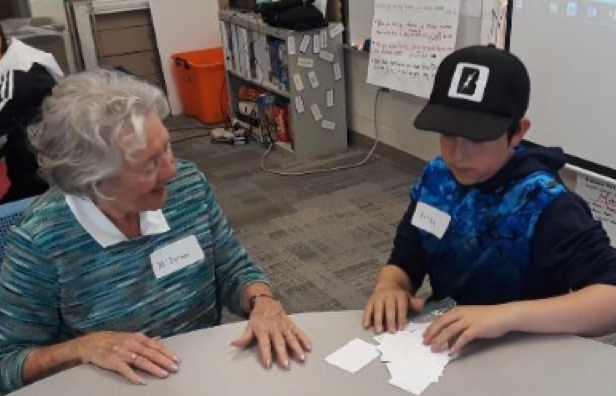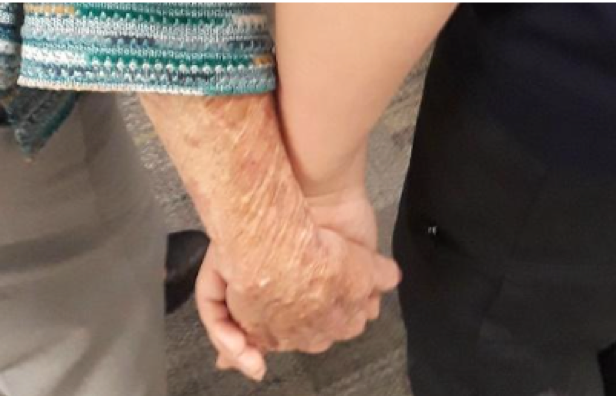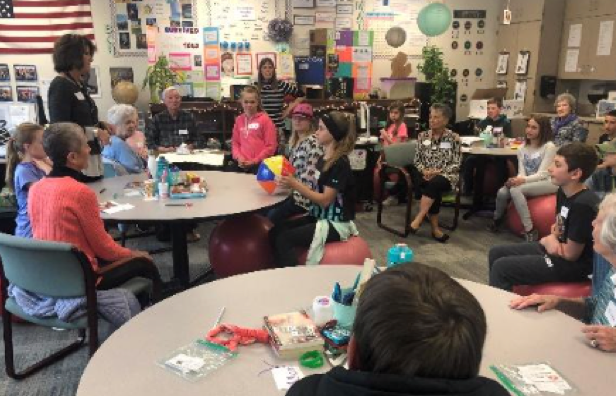
How can we make a memory live on forever?
Older generations have so much to teach us—if we take the time to listen. Every community has people who have lived long, full lives with valuable stories, knowledge, and skills to share. In this project, students will make friends with a resident of a retirement home. They will listen to the story of their new friend’s life, and craft a biography capturing the moments that made their life meaningful!
Imagine if teachers across the nation helped students connect with and learn from previous generations. What a powerful new perspective they would gain on life!



What’s included in your project?
Cross-Curricular Content
Every Blue Apple project provides suggested content correlations to Common Core State Standards, Next Generation Science Standards, and C3 Framework for Social Studies. A featured mini-lesson from each content area is highlighted below along with additional lesson ideas. Not teaching these standards? No problem! Check out the Moments to Remember K-8 content correlation document for additional lesson ideas.

Math
Number Sense and Equivalent Fractions
Lesson 7: As students develop their understanding of fractions, they gain a better sense of the relative size of fractions, especially in comparison to benchmark fractions like ½ and ¼. Have students create a “life-timeline” of their senior friend, convert important time periods into fractions of that person’s life. Then, compare them to benchmark fractions. CCSS.MATH.CONTENT.5.NF.A.2Using Parentheses
Lesson 3: Imagine a memory game with one wild card, which counts as a match with any card at all. After returning from the retirement home, have students evaluate the number of cards (c) there would be if they answered “n” prompts, determining that c = 2n + 1. Solve for several “n”s. CCSS.MATH.CONTENT.5.NF.A.1Powers of Ten
Lesson 6: As students construct their graphic organizers, encourage them to compare a 9-year-old and a 90-year-old; the senior has lived ten years for every one of the child’s. Compare the 90-year-old to the 9 in the year of the senior’s birth (1930, for instance). CCSS.MATH.CONTENT.5.NBT.A.1Whole-Number Division
Lesson 6: In the year 2024, some of your seniors may turn 92 years old. Have students find out how many 92-year lifetimes it would take to make it from year 0 to year 2024 by using division. CCSS.MATH.CONTENT.5.NBT.B.6

English Language Arts
Determine the Theme of a Story
Lesson 1: After reading Wilfrid Gordon McDonald Partridge, by Mem Fox, explore the idea of theme by connecting specific textual examples to a student-generated description of the book’s central idea. Expand your understanding of the concept by discussing the theme of other familiar works of literature. CCSS.ELA-LITERACY.RL.5.2Discuss with Diverse Partners
Lesson 3: As students interact with their senior friends, have them implement appropriate discussion techniques: following procedures for sensitivity, responding to questions and comments, and restating key ideas to summarize. CCSS.ELA-LITERACY.SL.5.1Comparing Stories within a Genre
Lesson 5: After sharing several biographies and autobiographies, discuss the similarities and differences of how authors work within the genre. CCSS.ELA-LITERACY.RL.5.9Integrate Informational Texts
Lesson 7: Introduce historical texts to students as they craft their biographies. Encourage students to draw connections between the events of their senior friend’s life and the broader historical context. CCSS.ELA-LITERACY.RI.5.9

Science
Patterns of the Night Sky
Lesson 2: Use star charts to explore the predictable patterns of the night sky. Then, use your study to draw a surprising connection: students who share a birth month with a senior citizen, even if they were born many years apart, were born under very much the same night sky! NGSS 5-ESS1-2Matter and its Interactions
Lesson 2: Before inflating the beach ball, describe how the beach ball will inflate because tiny particles of air enter into the ball, and that the pressure they exert on it will keep it inflated. The more air is put into the ball, the more the particles will inflate it. NGSS 5-PS1-1Protecting Earth’s Resources
Lesson 5: As people have learned about their environment, we have changed how we do things. Introduce several ways in which people would have interacted differently with the environment when their friends were young, compared with how we interact with our environment today. NGSS 5-ESS3-1Needs of Plants and Animals
Lesson 9: After presenting seniors with their biographies, consider keeping the connection between students and seniors by growing and sharing plants students have grown as gifts. Use the opportunity to teach students that plants get most of what they need from air and water. NGSS 5-LS1-1

Social Studies
Questions about Historical Figures
Lesson 2: Prior to visiting the retirement home, introduce students to two or three important historical figures who likely lived during the lifetime of their senior friends. Have students ask their senior friends questions about these historical figures during their discussion. NCSS D2.HIS.3.3-5Life in Different Eras
Lesson 5: As students prepare to write biographies for their senior friends, have them consider similarities and differences between life today and life during the childhood of their senior friend. Create a T-chart to help analyze the similarities and differences. NCSS D2.HIS.2.3-5Cultural Influences on Perspective
Lesson 6: Some seniors may have beliefs or hold opinions that are no longer as prevalent as they once were. Ask students if seniors expressed an opinion with which the student disagreed. Discuss what cultural or historic causes may have contributed to this difference. NCSS D2.HIS.5.3-5Differing Points of View
Lesson 8: As students revise their story, they may identify areas in which they viewed an event or an issue differently than their senior friend. Collect several examples of this and ask students, “What experiences do you think caused the senior and the student to view this experience differently?” NCSS D2.CIV.10.3-5

Social Emotional Learning
- Relationship Skills and Social Awareness
Lesson 1: Collaboration skills are critical in the twenty-first century, but we rarely take time to teach them explicitly. Help your students explore relationship skills and social awareness by discussing, modeling, and practicing using empathy and compassion to prepare for their visit with senior friends.
Not teaching these standards?
No problem! Check out the Moments to Remember K-8 content correlation document for additional lesson ideas.
Each Blue Apple Project Includes:

- Engaging lessons designed to make learning memorable, meaningful, and fun
- Curated online resources to save you time searching for content
- In-person, virtual, and hybrid options for all learning environments
- Cross-curricular mini-lessons in English-Language Arts, Math, Science, Social Studies, and Social-Emotional Learning
- Videos and contact info provided by real-world experts willing to meet with your students
- Opportunities to collaborate with other classrooms doing the same project
- Free project supplies to get you started right away

